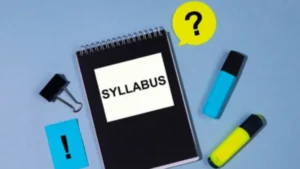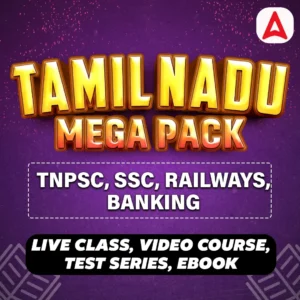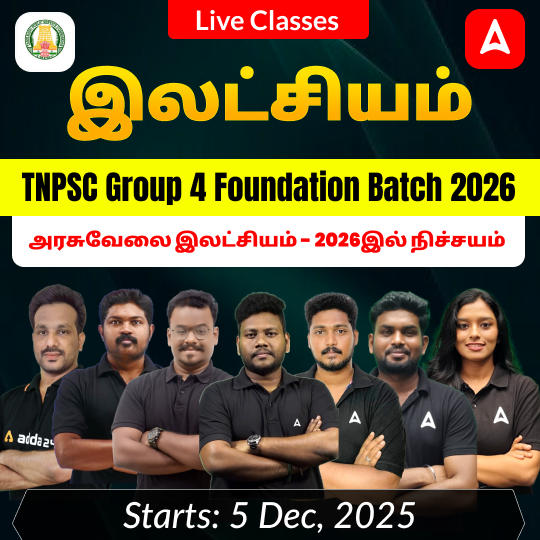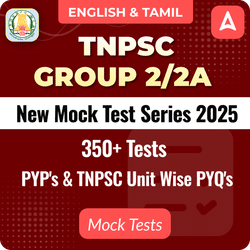The Tamil Nadu Cooperative Bank Assistant Syllabus and Exam Pattern 2025 is essential for candidates preparing for the upcoming recruitment exam. Understanding the detailed syllabus and latest exam structure helps aspirants plan an effective strategy and focus on high-scoring topics. This article provides a complete overview of the TN Cooperative Bank Assistant Syllabus along with the subject-wise exam pattern. Candidates can also download the official syllabus PDF for streamlined preparation.
Tamil Nadu Cooperative Bank Assistant Syllabus
The Tamil Nadu Cooperative Bank has announced recruitment for 2,513 Assistant posts, presenting a valuable opportunity for job seekers in the state. To crack this competitive exam, it is essential to have a clear understanding of the Tamil Nadu Cooperative Bank Assistant Syllabus 2025.
The updated syllabus acts as a roadmap, guiding candidates on what to study and how to structure their preparation. With a subject-wise breakdown, aspirants can focus on important topics, boost their confidence, and improve their chances of selection in the upcoming exam.
Tamil Nadu Cooperative Bank Assistant Syllabus: Overview
The Tamil Nadu Cooperative Bank Assistant Syllabus 2025 provides candidates with clarity on the subjects they need to prepare for the written examination. Aspirants must follow the official syllabus to ensure they are focusing on the right topics for each section. Below is a quick overview of the recruitment:
| TN Bank Cooperative Assistant Syllabus | |
| Organisation Name | Tamil Nadu Cooperative Institutions/District Central Cooperative Bank |
| Job Category | Tamil Nadu Govt Jobs |
| Post Name | Assistant/ Supervisor/Clerk/Junior Assistant |
| Total Vacancy | 2513 |
| Category | Syllabus and Exam Pattern |
| Job Location | Tamil Nadu |
| Official Website | https://www.tncoopsrb.in/ |
TN Cooperative Bank Assistant Syllabus 2025
To crack the Tamil Nadu Cooperative Assistant Exam, candidates must follow the official syllabus without deviation. Here’s the exact syllabus as per the official notification.
1. Concept and Principles of Cooperation
a. Concept of Cooperation – ICA Definition of Cooperation – ICA
b. Principles of Cooperation
Evolution:
- 1973 – London, England
- 1966 – Paris, France
- 1995 – Manchester, England
c. Cooperative Values
- Self-Help
- Self-Responsibility
- Democracy, Equality, Equity, Solidarity
2. Pioneers of Cooperative Movement in India and Abroad In India
- P.T. Thegaraya (1852–1925) – Chennai
- P.S. Kumarasamy Raja (1898–1957) – Rajapalayam
- Dr. P. Natesan (1902–1974) – Salem
- K.A. Nachiappa Gounder (1904–1951) – Salem
- M.P. Nachimuthu (1914–1987) – Chennimalai, Erode
- P.S. Rajagopal Naidu (1914–2009) – Vellore
- K.S. Subramania Gounder (1921–1982) – Salem
Abroad
- Robert Owen (1771–1858) – Wales
- Charles Fourier (1772–1837) – France
- Dr. William King (1786–1865) – England
- Herr Franz Schulze (1809–1883)
- Herr F.W. Raiffeisen (1818–1888) – Germany
- Rochdale Pioneers (1844) – Manchester, England
3. Cooperative Movement in India – Evolution and Growth
a. Pre-Independence (1875–1946)
- Sir Frederick Nicholson Report – Find Raiffeisen (1895 & 1897)
- Edward Maclagan Committee on Cooperation – 1914
- Royal Commission on Agriculture in India – 1928
- Cooperative Planning Committee – 1946
b. Post-Independence (1947–1990)
- Five Year Plans and Cooperative Development (1951 to 2017)
- National Council for Cooperative Training – 1962
- National Cooperative Development Corporation – 1963
- Committee on Cooperation – 1965 (Shri. Ram Niwas Mirtha, Chairman)
- All India Rural Credit Review Committee – 1969 (Shri. B. Venkatappiah, Chairman)
- Agriculture Credit Review Committee – 1989 (Shri. A.M. Khusro, Chairman)
4. Cooperatives After Implementation of New Economic Policy (1990)
- Narsimham Committee on Banking Sector Reforms – 1998
- Task Force on Revival of Short-Term Cooperative Credit Structure – 2005 (Prof. Vaidyanathan, Chairman)
5. Cooperative Movement Abroad
a. In Germany
- Raiffeissen Societies
- Schulze Delitzsch Societies
- Insurance / Housing
b. In Great Britain
- Rochdale Pioneer Equitable Society
- Retail Stores
- Cooperative Wholesale Society
- Consumer Cooperatives
- Agricultural Cooperatives
- Insurance / Housing / Credit
- Cooperative Education
- Cooperative Union
c. In Denmark
- Agriculture Cooperatives
- Consumer Cooperatives
- Cooperative Dairies
- Credit / Insurance / Housing
- Cooperative Egg and Bacon Societies
d. In Japan
- Agriculture Cooperatives
- Fishing Cooperatives
- Consumer / Credit / Industrial
- Prefectural Unions and Federations
e. In USA
- Agriculture Credit
- Purchasing and Marketing Associations
- Rural Service Cooperatives
- Healthcare Cooperatives
f. In Italy
- Banca Popolare (People’s Bank)
- Cassa Rurale (Rural Banks)
- Farming Society
- Labour Society
g. In France
- Agriculture Cooperatives and Syndicate
- Insurance / Housing / Fisheries
- Workers Cooperatives
h. In Israel
- Kibbutzim and Moshavim (Agriculture Cooperatives)
- Agriculture / Credit / Consumer / Production
- Consumer Cooperatives
i. In Sweden
- Kooperative Forbundet (KF) – Central Retail Society
- Cooperative Farming Society
- Credit / Insurance / Housing / Education
- Burial Societies
j. In China
- Cooperative Credit
- Industrial Cooperatives
- Supply and Marketing Cooperatives
6. Cooperative Law
a. Evolution of Cooperative Legislation in India
- Sir Edward Law Committee (1901)
- Cooperative Credit Societies Act, 1904
- Cooperative Societies Act, 1912
- Montague Chelmsford Constitutional Reforms Act, 1919
- The Madras Cooperative Societies Act, 1932
- Multi Unit Cooperative Societies Act, 1942
- All India Rural Credit Survey Committee – 1954 (A.D. Gorwala, Chairman)
- Tamil Nadu Cooperative Societies Act, 1961
- Tamil Nadu Cooperative Societies Act, 1983 and Rules, 1988
- Tamil Nadu Cooperative Societies (Amendment) Act, 1989
- Committee on Cooperative Law for Democratisation and Professionalization of Management in Cooperatives – 1985 (Shri K.N. Ardhanareeswaran, Chairman)
- Committee on Model Cooperative Act – 1991 (Shri Choudhary Brahm Prakash, Chairman)
- Multi-State Cooperative Societies Act, 2002
- Constitution Amendment Bill, 2006
- Constitution (97th Amendment Act), 2011
b. Important Provisions of TNSCS Act, 1983
- Registration of Cooperative Society – Sections 8 to 10
- Bylaws and Amendment of Bylaw – Section 11
- Membership of Cooperative Societies – Section 21
- Management of Registered Society – Section 32
- Meetings of the Board – Section 33
- Duties and Privileges of Registered Society – Section 37
- Disposal of Net Profits – Section 72
- Inquiry – Section 81
- Inspection and Investigation – Section 82
- Maintenance of Accounts and Books – Section 84
- Surcharge – Section 87
- Supersession of Board – Section 88
- Settlement of Disputes – Section 90
- Winding up of Registered Society – Section 137
- Execution of Decrees, Decisions, Awards, and Orders – Section 143
- Appeal, Revision, and Review – Sections 152, 153, 154
C. Allied Law as Applicable to Cooperative Societies
- Indian Penal Code
- Essential Commodities Act
- Payment of Gratuity Act
- Code of Civil Procedure
- Indian Contract Act
- Payment of Bonus Act
- Tamil Nadu Shops and Establishment Act
- Negotiable Instruments (NI) Act and Banking Regulation (BR) Act
- Limitation Act
7. Cooperative Management
a. Functions of Management
- Planning, Organising, Directing, Staffing, Controlling
- Levels of Management
- Principles of Management
- Leadership
- Communication
- Motivation
b. Decision Making
- Individual Decision Making
- Group Decision Making
c. Features of Cooperative Management
- Professional Management of Cooperatives
- Problems and Prospects of Cooperatives
- Difference between Cooperative Management and Private Management
d. Management of Credit Cooperatives
- Rural Credit Cooperatives
- Urban Credit Cooperatives
e. Management of Non-Credit Cooperatives
- Producer / Industrial Cooperatives
- Marketing Cooperatives
- Processing Cooperatives
- Consumer Cooperatives
- Dairy Cooperatives
- Weavers Cooperatives
- Fisheries Cooperatives
- Housing Cooperatives
f. Functional Areas of Cooperative Management
- Production Management
- Materials Management
- Marketing Management
- Financial Management
- Human Resources Management
g. Office Management
- Office Procedures
- File and Record Maintenance
- Official Correspondence and Communication
- Discipline and Disciplinary Action
- Time Management
- Records and Registers to be maintained by Officers of Cooperatives
8. Cooperative Education and Training
- Role of Cooperative Education and Training in Member and Employee Development
- Institutions for Member Education
- Cooperative Training Institutions in the State and the Country
9. Cooperative Administration
a) Administration
- Organisational Structure of Cooperatives
- Cooperative Department Setup
- Role and Functions of Registrar of Cooperative Societies
- Functional Registrars
- Duties and Responsibilities of Secretary / Manager of Cooperatives
- Monitoring and Supervision
- Powers and Functions of Managing Director or Chief Executive
b) Management Committee
- Role and Functions of Board of Directors
- Role of President / Chairman
- General Body Meeting
- Conduct of Annual General Meeting (AGM) and Special General Meeting (SGM)
- Functions and Powers of General Body
c) Cooperative Elections
- Authority for Conducting Elections
- Disqualification to Vote or Contest in Elections
- Disqualification to be a Member of Management Committee
- Composition of Management Committee
- Offences and Penalties Related to Election
- Mode and Conduct of Election
- Reservations and Division of Constituencies
- Election of Office Bearers
- Postponement of Elections
- Role of Election Officers
- Custody and Prevention of Records
10. Cooperative Credit & Banking
a) What is Credit?
- Classification of Credit
- Need for Institutional Agricultural Credit
- Agricultural Credit and Cooperatives
- Essentials of Cooperative Credit
- Evolution and Growth
- Revival of Rural Cooperatives
- Case Study – PACCS (Primary Agricultural Cooperative Credit Societies): Objectives, Membership, Liability, Management, Staff, Functions, Sources of Funds: Share Capital, Reserve, Deposit, Borrowings, Medium-Term (MT) Conversion and Deposit
- Needs for Production and Development Credit, Importance and Characteristics of Agricultural Credit
Types of Credit: Short-Term, Medium-Term, Long-Term Credit, Need for Institutional Credit for Agricultural and Rural Development, Credit Classification: Production Credit, Consumption Credit
b) Structure of Credit Cooperatives
- Federal / Unitary / Mixed Type Structures
- Need for Integration of Short, Medium, and Long-Term Credit Structure (Single Window System)
- National Federation of State Cooperative Banks (NAFSCOB)
- National Federation of Agriculture and Rural Development Banks
- Role of Federations in Cooperative Banking Development
- Role and Functions of PACCS in Agri-Finance for Rural Development:
- Service Area Approach (SAA)
- Business Development Plan (BDP)
- Development Action Plan (DAP)
- Computation of Break-Even Level of Business
- Kisan Credit Card (KCC)
- Innovations in Rural Credit
c) Central Cooperative Banks (DCCB)
Organisation, Membership, Management, Objectives, Functions and Working, Mobilisation of Resources, Lending: Types of Loans, Agricultural Lending, Non-Farm Sector Finance, Loan Sanction Procedures, State Cooperative Banks’ Role, NABARD and Other Agencies’ Role, Lending Specifics: Seasonality in Lending, Scale of Finance, Minimum Involvement and Non-Overdue Cover, Loan Disbursement, Loan Supervision and Recovery, Latest Progress, Problems and Remedies
d) State Cooperative Banks (Apex Banks)
Organisation, Management, Objectives, Functions and Working, Short-Term Finance from NABARD to SCBs, Assistance to Weavers’ Cooperatives, Assistance to Sugar Factories, Memorandum of Understanding (MoU) for Functions, Role of Apex Banks in Cooperative Movement Development, Latest Progress, Challenges and Remedies
e) Priority Sector Lending
Lending to Self Help Groups (SHGs), Joint Liability Groups (JLGs), Rural Artisans, Loans to Weaker Sections
f) Role of NABARD (Repeated for Integration)
Genesis, Objectives, Management, Functions, Refinance Assistance to Agricultural Credit Cooperatives, Procedure and Norms of NABARD for Refinance, Financial Inclusion, Microfinance,
- Promotion of: SHGs, JLGs, Farmers Club, Contract Farming, Agri Clinic
Cooperative Banking :
a. Meaning and Definition of Bank – Banking System – Cooperative Banking Definition – Types – Features – Management commercial Banks – Cooperative banks Vs. Commercial banks – RRBs – Local Area banks – progress of institutional Credit – Banker and Banking, Functions of Banks, Banker Customer Relationship. Productivity in Banks – Social Aspect of Banking – Concept of Development Banking.
b. Banking Operations – Mobilization of resources – Acceptance of Various Types of Deposits – Procedure for opening and operation of Various Types of Accounts and Various Types of Customers – Documentation for Various Loans – Activities of banks – Agri – Activities to Allied Activities – Social banking.
c. Management of Funds in Banks (Cost and yield on Assets, cost of Management, Risk cost, Miscellaneous Income, Average Working Fund, Gross Margin, Net Margin, Average Cost of Deposit), Break Even Point Prime Lending Rate – Principles of Good Lending and Investment, Profit Planning – Consortium Advances, Merchant Banking – Cash Management.
d. Management of Overdues Causes for Overdues and Remedies – Recovery ethics/ important Recommendations of Committee on Overdues. Non – performing Assets – assets Classification, Income Recognition and Provisioning Norms, Capital Adequacy Norms. meaning of Overdue – Creation of Changes on Securities at the time of extending loans – Securitization and Reconstructions of Financial Assets and enforcement of Security Interest (SARFAESI) Act -2002 and Debt Recovery Tribunal (DRT).
e. Important provisions of Negotiable instrument Act 1881
f. Important provisions of B.R.Act 1949 (As applicable to Cooperative Societies, 1966) – Regulatory issue, importance of KYC prevention of Anti money Laundering Act (PAMLAC) Base 1 Committee 1,2,3- inspection/ Supervision of Cooperative Banks – Issue of Policy guidelines as per the directives of RBI issued now and then – banking regulation and Minimum Capital to be maintained as per section 11- Maintenance of Cash Reserve Ration(DRR) Section 18 – Maintenance of Statutory Liquidity Ratio (SLR) Section 24 – Restriction on loans and advances – RBIs power to control advances – licensing – opening of new places o0f business – return of unclaimed deposits – monthly returns – accounts and balance sheet – submission of returns and publication inspection – penalties – coop banks nomination rules 1985– registration and acknowledgement – the banking regulation and miscellaneous provisions bill 2003 – plight of coop banks – circulars.
g. Banking Services – ATM, Credit Cards, Debit Cards, Collection Remittance, Agency Services, Administrative Services, Trusteeship Clearing House – (RTGS) Real time Gross settlement (NEFT) National Electronic Fund Transfer – ECS Debit and credit – Cheque Truncation IFSC Code
h. Inspection / Supervision of Cooperative banks – Issue of Policy guidelines as per the directives of RBI issued now to them.
3. COOPERATIVE ACCOUNTING :
a) Commerce – Meaning and Definition of Commerce – Objectives of Commerce – Functions of Commerce, Types of Commerce – Business Environment – Economic Environment – Economic Policies – Liberalization, Privatization and Globalization – International Economic institutions – World Trade Organizations and its Functions, policies – Promotion of Foreign Trade.
b) Definition Meaning – objectives of Accounting, scope of Accounting types of Accounting – Functions of Accounting, Accounting principles concepts – Entity concept, Dual Aspect concept, Accounting period concept – going concern concept – Cost concept – money measurement concept – matching concept – Realization concept – Accrual concept –Rupee value concept, Accounting Conventions.
c) Double Entry System of Accounts: Historical Development Double aspects of transaction, Rule of Double Entry System, Personal accounts, Real accounts, Nominal accountsAdvantages of double entry system. Books of original records – journal entry – steps in posting – Special journals – Cash book/ Day book – Ledger postings – Trial Balance –preparation of Trial Balance – Advantages of preparing a trial balance.
d) Final Accounts: Meaning – manufacturing Account, Method of preparing final Accounts – Trading Account, Profit and Loss Account – Balance sheet operating Expenses – Non operating expenses – operating expenses – non operating expenses. Assets and Liabilities – Classification of Assets and Liabilities – Adjustment entries –Treatment of loans and subsidies in Accounts. Banking Transactions – Bank Reconciliation Statement Depreciation of Accounting.
e) Cooperative – Accounting : Introduction of Cooperative Accounting – objectives – Rough Cash Chita- journal – Cashbook – Daybook – Ledgers – statement of Receipts and Disbursement – Final Accounts – Balance sheet – Current assets – fixed assets – Tangible and intangible assets – wasting assets – Distribution of net profits – creation of reserves – adjustment entries – Difference between cooperative Accounting and double Entry System. Advantages and disadvantages of Cooperative accounting common Accounting System in Cooperatives. computerized Accounting.
4. Cooperative Audit:
Meaning and objectives of Cooperative Audit – nature and scope of audit Types of audit – Duties and responsibilities of auditor – Auditing standards – computerized Audit – Hardware and Software. Internal control and internal check – nature and objectives of internal control and internal check – Review of internal control – Audit programme – Verification of assets – valuation of assets – provisions of laws – preparation of Audit Report – Classification of Different Audit – concurrent audit – Statutory audit – cost audit – management audit – performance and efficiency audit – social audit.
MIS AND COMPUTER APPLICATION /COMPUTER FUNDAMENTALS
A. COMPUTER FUNDAMENTALS :
Introduction to computer – Computer Hardware and Software –Computer System Characteristics – Components of Computer – Input Device– Central Processing Unit – Output Device – Random Access Memory (RAM)– Read only Memory (ROM), Programmable Read only Memory (PROM), Electrically erasable Programmable Read only Memory (EEPROM), Cache, Register and other types of computer Memory – Types of Computer – Generation of Computers – Computer Viruses – Different Type of Viruses –Worms, Trojan Horses. OPERATING SYSTEMS: Objectives and Functions, Evolution of Operating Systems up to windows – Computer system organization – Operating system Structure and Operations.
B. MANAGEMENT INFORMATION SYSTEM (MIS)
Understanding MIS: Data and information – Introduction to management Information system – Role and Importance and functions of MIS – the Structure of Management information system – types of information system Business Application of Information system – Enterprise systems Enterprise Resource Planning (ERP), Customer Relationship Management (CRM), Supply chain Management (SCM), Decision Support Systems (DSS), Types of decisions, Decision support techniques, and Decision making and Role of MIS, Business intelligence and knowledge management systems. Security, Ethical & Social Issues: Information Security (IS) Security threats. Protecting IS, IS Security Technologies. Social Issues.
C. COMPUTER APPLICANTS :
Microsoft Word: Introduction: – Word Processor – Features of Microsoft Word 2007 Components – Open & Save Microsoft Word documents with different option – formatting – Advanced formatting Techniques – Types of views –Mail Merging – Find & Replace – Spell Check – Auto Text – Book mark – Headers & Footers – Editing Documents – Printing Documents. Spread sheet: – Introduction – Microsoft Excel Features – Entering and Editing Date – Addressing Techniques – Simple formulas & Functions -formatting Cells – Aligning Cells – Copying and Linking cells and sheets –Fill methods – Data Analysis – Built – in – Functions – Types of Charts –Goal Seek – Auditing – Sorting – Freezing panes – Inserting Objects & Pictures – Printing options. Microsoft PowerPoint
Creating a Presentation: Creating a Presentation Using a Wizard Exploring and Moving around a Presentation – Changing Text in the outline pane, Slide Pane – Reversing one or more Action – Changing Presentation Views, Properties – Previewing slides and Saving Presentations Using the Design Template: Entering Text into Slide/outline/Notes pane Creating a New Slide – Editing in Normal View – Entering Speakers’ Notes Rearranging Slides in slide sorter view – Showing Slides.
Producing an Slide Show: Navigating in slide Show View – Setting Text Transitions – Animating Slides – Normal View – Slide Sorter View – Custom Slide Show Options.
Printing a Presentation: Opening an Existing Presentation – Reviewing slides in Black and White – Adding a Header and a Footer – changing the page Setup – Choosing a printer – Printing Slides, Speaker Notes.
D.IT ENABLED SERVICES :
Network Classification & Data Communication Services: Local Area Network (LAN) – Metropolitan Area Network (MAN) – Wide Area Network (WAN) – Wireless Networks – Inter Networks – Network Applications – File Transfer Protocol (FTP – E-Mail
E-Technologies: Payment Gateway – Electronic Payment System – Real –Time Gross Settlement (RTGS), National Electronic Funds Transfer (NEFT), Core Banking System (CBS), E-Commerce-E-Governance-Information Security – Cyber Crime – Cyber Security – Legal Aspects of Cyber Crime. Mobile Computing: Framework, Mobile Information access devices. Mobile Computing applications.
Network Security: Doman Name System (DNS) – Digital Signature Symmetric Key Signatures. Public Key Signatures.
GENERAL STUDIES :
UNIT – I- General Science :
Physics- Nature of Universe – General Scientific laws – Invention and discoveries – Science glossary – science terminology –force and pressure Motion – Motion& liquids – work, power, energy and hear – Electricity and heat – Light and sound
Chemistry: Elements and compounds – Carbon, nitrogen and their compounds – Fertilizers, Pesticides, Insecticides – Environmental effects of insecticides.
Botany – Concepts of life Science – Plant cells – Plant tissues – Plant functions – plant nutrition – Nutrition in plants and animals – basis unit of the life – Classification of living organism – Nutrition and Dietetics –Respiration Excretion of metabolic waste.
Zoology: Blood and Blood circulation – Endocrine System – Reproductive System – Genetics – the Science of heredity – Environment, Ecology, health and hygiene –immune system – Bio-diversity and its conservation – Human diseases. Prevention and Remedies – Communicable diseases and non Communicable diseases.
UNIT – II Current Affairs :
Important Current affairs of State, National and international – Eminent
persons – Sports & Games – Books & authors – Awards & honors – Welfare
oriented Government Schemes – Geographical land marks – Current Socio
economic problems – Latest invention on science and technology – India’s
space programmes – India’s missile programmes.
UNIT – III – Geography
Earth and Universe – solar System – Atmosphere of Earth – Composition – Structure of atmosphere – Monsoon – Winter – Summer – Features of Monsoon – Rainfall – Weather and Climate – Water Resources – Rivers in India – Plains and Plateaus in India – Soil Fertility – Types of Soil – Sustainable development and soil Conservation _ Minerals & Natural resources – Renewable Resources – Non – Renewable resources – Types of Natural vegetation – Importance of Forests and Wildlife – Agricultural pattern Livestock & fisheries – Transport System in India – Remote Sensing– Social geography – Livestock – Animal Diseases – Fisheries – Flora and Fauna – Population density and distribution – Natural Calamities – Ozone Layer Depletion – Global Warming – Acid Rain _ Water Pollution – Noise Pollution – Bio – medical waste pollution – Disaster management -Mitigation measures.
UNIT – IV – History of India
History and culture of India – pre historic events – Indus valley Civilization Vedic, Aryan and Sangam age – Maura dynasty – Buddhism and Jainism – Guptas, Delhi Sultanate, Mughals and Marathas – Age of Vijayanagaram and the Bahmani Sultans History of Tamil Nadu – Culture and Heritage of Tamil Nadu.
Growth of Rationalist and Dravidian movement in Tamil Nadu – Social transformation in Tamil Nadu Socio – Religious Reform Movements in India – Brahmo Samaj – Prarthana Samaj – Arya Samaj – Theosophical Society – Ramakrishna Mission – Samrasasuddhasanmargasangam – Aligarh Movement. India since Indepedence
UNIT – V- India Polity
Constitution of India – Preamble to the constitution – Salient features of constitution – Union, State and Union Territory – Citizenship – Fundamental rights – Fundamental duties – Human Rights Charter – Union Legislature – Parliament – Lok Sabha – Rajya Sabha – Powers of Parliament– State executive – State Executive Powers – State legislature – Legislative powers – Special Status of Jammu & Kashmir – Local Government –
Panchayat raj Institutions – Judiciary in India – Rule of Law / Due Process of Law – Indian Federalism – Center – State relations – Legislative relations – Administrative relations- financial relations – Emergency provisions –Official Language – Amendments to the Constitution – Schedules to the Constitution – Right to Information Act – Central and Sate Information Commissions – Consumer Protection Act, 1986.
UNIT – VI – Indian Economy :
Nature of Indian Economy – Planning in India – Five Year Plan Models – An Assessment – Agriculture, Industrial growth – Emergence of Service Sectors in the national Income – Public Finance and Fiscal Policy – Finance Commissions – NITI Ayog – Banking, Money & Monetary Policy – Foreign Direct Investment (FDI) – WTO – Globalization and privatization – Rural Welfare Oriented Programmers – Socio – Economic problems – Population education, health, employment, poverty – Sustainable economic growth –Economic development in Tamil Nadu – Energy – Different Sources and development.
UNIT – VII- Indian National Movement :
Advent of European powers in India – Invasion, Expansion and Consolidation of British rule in India – Early Uprising against British rule – 1857 revolt – National renaissance – Indian National Congress – Emergence of National leaders – Gandhi an Era – Different modes of agitations – world wars and final phase struggle – Communalism led to partition of India Integration of States – role of Tamil Nadu in freedom struggle.
UNIT – VIII – Aptitude and Mental Ability Tests :
Quantitative aptitude – Numerical ability – Simplification – Percentage –Highest Common Factor (HCF) – Lowest Common Multiple (LCM) – Ratio and Proportion – Simple interest – Compound interest – Geometry – Area Volume – Time and Work Conversion of information to date – collection, compilation and presentation of data – tables, graphs, diagrams – Parametric representation of data Analytical interpretation of data.
Reasoning – Decision makes and problem solving – Logical reasoning –Puzzles – Dice problems – Visual reasoning – Alpha numeric reasoning Number series – Logical number / Alphabetical / Diagrammatic Sequences.
Tamil :
1. History of Tamil Language:-
Dravidian languages Tamil, Telugu, Kannada, Malayalam, Thuluvam The oldest is Tamil language – Tolkappiyam The oldest grammar book, BC. Predates the 2000th century. Tamil language Classical language – Short essay.
2. History of Tamil Literature:- The first association, Inter-Association, Shop association, The period when the Sangam disappeared was the 3rd century AD.1. Sangam period literature :- Ten-song, eight-volume books
3. The time when the Sangha was forgotten:- 3rd century AD Kalabhir period, law books, eighteen-digit arithmetic books
4.Puranas, Epics, Five Poems Five great epics
5. Grammar Texts:- Archive, internal, good book
6. Tamil Pulavars :- Thiruvalluvar, Ilangovadis, Olavaiyar, Kapil, Nakkir, Crow singer, Kalamegappulavar, Vedanayagam Pillai, Bilaterals, Bharatiyar, Bharathidasan, Poet Kannadasan, Poet Vali and Vairamuthu
7. Tamil scholars: Dr. U.V. Swaminatha Iyer, Dr. M. Varadarasanar, Scholar Rajaji and Annadurai, Dr. Artist Karunanidhi, Dr. M.G. Ramachandran, T Their story and prose
8. Contemporary Literature: Short story and drama, Short story – Akilan, Dramas are contemporary dramas, Notes on Film Dramas
Tamil Nadu Cooperative Bank Assistant Exam Pattern 2025
Candidates appearing for the TN Cooperative Bank Assistant exam should note that the written test lasts 180 minutes and includes a 0.25 mark penalty for each wrong answer. The paper covers six key sections assessing various skills relevant to the role.
| Tamil Nadu Cooperative Bank Assistant Exam Pattern 2025 | |||
| Section No. | Subjects | Number of questions | Total Marks |
| 1 | Principles and Practices of Cooperative Management | 50 | |
| 2 | Cooperative Banking and Credit Systems | 50 | |
| 3 | Fundamentals of Cooperative Accounting | 25 | |
| 4 | Basics of Computer | 25 | |
| 5 | General knowledge and Current Affairs | 25 | |
| 6 | Tamil Language Proficiency | 25 | |
| Overall | 200 Questions | 170 Marks | |
TN Cooperative Bank Assistant Syllabus PDF
Aspirants preparing for the TN Cooperative Bank Assistant Exam 2025 can now access the complete syllabus in PDF format. The official syllabus outlines all the important topics across each section of the exam, helping candidates plan a focused and strategic preparation.
Click the link below to download the TN Cooperative Bank Assistant Syllabus 2025 PDF and start your exam preparation with clarity and confidence.
Tamil Nadu Cooperative Bank Assistant Syllabus 2025
| Also check |
| Tamil Nadu Cooperative Bank Assistant Salary |



 TGSRTC Syllabus & Exam Pattern 2026 ...
TGSRTC Syllabus & Exam Pattern 2026 ...
 OSSSC Excise Constable Syllabus and Exam...
OSSSC Excise Constable Syllabus and Exam...
 UPPSC Syllabus and Exam Pattern 2026, Ch...
UPPSC Syllabus and Exam Pattern 2026, Ch...



 Adda247 Job portal has complete information about all Sarkari Jobs and Naukri Alerts, its latest recruitment notifications, from all state and national level jobs and their updates.
Adda247 Job portal has complete information about all Sarkari Jobs and Naukri Alerts, its latest recruitment notifications, from all state and national level jobs and their updates.



